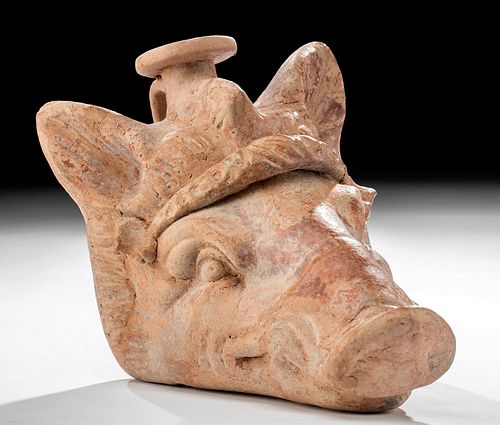Greek Archaic Terracotta Aryballos - Boar Form
Lot 18c
About Seller
Artemis Gallery
686 S Taylor Ave, Ste 106
Louisville, CO 80027
United States
Selling antiquities, ancient and ethnographic art online since 1993, Artemis Gallery specializes in Classical Antiquities (Egyptian, Greek, Roman, Near Eastern), Asian, Pre-Columbian, African / Tribal / Oceanographic art. Our extensive inventory includes pottery, stone, metal, wood, glass and textil...Read more
Estimate:
$5,000 - $7,000
Absentee vs Live bid
Two ways to bid:
- Leave a max absentee bid and the platform will bid on your behalf up to your maximum bid during the live auction.
- Bid live during the auction and your bids will be submitted real-time to the auctioneer.
Bid Increments
| Price | Bid Increment |
|---|---|
| $0 | $25 |
| $300 | $50 |
| $1,000 | $100 |
| $2,000 | $250 |
| $5,000 | $500 |
| $10,000 | $1,000 |
| $20,000 | $2,500 |
| $50,000 | $5,000 |
| $100,000 | $10,000 |
| $200,000 | $20,000 |
About Auction
By Artemis Gallery
Feb 13, 2020
Set Reminder
2020-02-13 10:00:00
2020-02-13 10:00:00
America/New_York
Bidsquare
Bidsquare : Exceptional Antiquities, Asian, Ethnographic
https://www.bidsquare.com/auctions/artemis-gallery/exceptional-antiquities-asian-ethnographic-4848
An important one-day auction featuring museum-worthy examples of Egyptian, Greek, Roman, Etruscan, Near Eastern, Far East / Asian, Pre-Columbian, African / Tribal, Oceanic, Native American, Spanish Colonial, Russian, Fossils, Ancient Jewelry, Fine Art, so much more! Artemis Gallery info@artemisgallery.com
An important one-day auction featuring museum-worthy examples of Egyptian, Greek, Roman, Etruscan, Near Eastern, Far East / Asian, Pre-Columbian, African / Tribal, Oceanic, Native American, Spanish Colonial, Russian, Fossils, Ancient Jewelry, Fine Art, so much more! Artemis Gallery info@artemisgallery.com
- Lot Description
Greek, probably eastern Greece / Rhodes, late Archaic period, ca. early 6th century BCE. A dramatic aryballos in the shape of a boar's fierce head, complete with protruding tusks, small eyes, a powerful snout, and large, pointed ears with a narrow spout terminating in a broad, flat rim between them. A delicate strap handle attaches to the upper neck of the spout and the back of the boar's head. A thin garland is wrapped across the boar's forehead, perhaps signifying that the animal depicted is an offering in a religious ceremony. Remains of dark red pigment on the snout given an idea of the vessel's original coloration. An aryballos is a vessel with a small, round/ovoid body and a narrow neck terminating in a slightly flared, very narrow spout. The broad, flat lip is designed to prevent spillage. Size: 6" W x 4.8" H (15.2 cm x 12.2 cm)
We know this object is from eastern Greece because of its unique shape: animals, warriors' heads, and other mold-made figures became the body of aryballoi in this area. This would have served as a container for scented oil or medicine, owned by an athlete. The Archaic period saw a marked change in Greek art, from abstract, geometric forms to a naturalistic style influenced by Egypt and the Near East, here on full display.
Provenance: ex-William Froelich collection, New York, USA, acquired in the 1970s
All items legal to buy/sell under U.S. Statute covering cultural patrimony Code 2600, CHAPTER 14, and are guaranteed to be as described or your money back.
A Certificate of Authenticity will accompany all winning bids.
We ship worldwide and handle all shipping in-house for your convenience.
#152789Repaired from multiple pieces, with thin lines of restored material along the repairs. Small loss on one back side of the head. Nice preservation of form with great deposits on surface.Condition
- Shipping Info
-
All shipping is handled in-house for your convenience. Your invoice from Artemis Gallery will include shipping calculation instructions. If in doubt, please inquire BEFORE bidding for estimated shipping costs for individual items.
-
- Buyer's Premium



 EUR
EUR CAD
CAD AUD
AUD GBP
GBP MXN
MXN HKD
HKD CNY
CNY MYR
MYR SEK
SEK SGD
SGD CHF
CHF THB
THB















